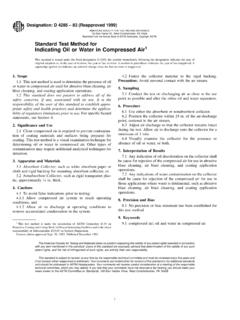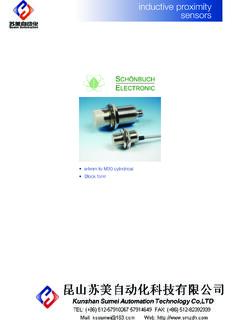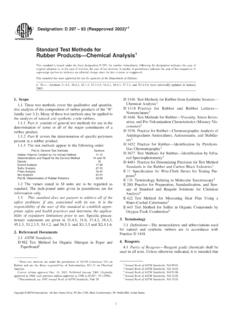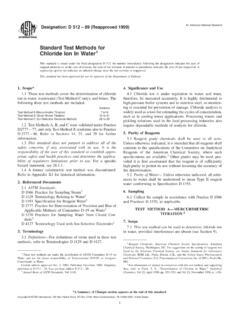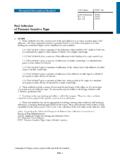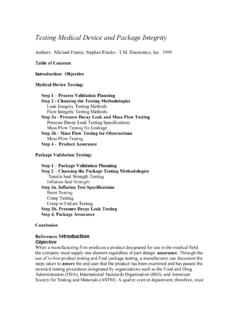Transcription of Standard Test Method for Peel Adhesion of Pressure ...
1 Designation: D 3330/D 3330M 02e1 Standard Test Method forPeel Adhesion of Pressure - sensitive Tape1 This Standard is issued under the fixed designation D 3330/D 3330M; the number immediately following the designation indicates theyear of original adoption or, in the case of revision, the year of last revision. A number in parentheses indicates the year of lastreapproval. A superscript epsilon (e) indicates an editorial change since the last revision or The US Customary units were corrected in the last sentence of in December These test methods cover the measurement of the peeladhesion of Pressure - sensitive Test Method A gives a measure of the adherence,when peeled at 180 angle.
2 To a Standard steel panel or to othersurface of interest for a single-coated Test Method B gives a measure of the adherence to thebacking of a single-coated Test Method C gives a measure of the adherence ofdouble-coated tape to a Standard steel panel or other surface Test Method D gives a measure of the adherence of therelease liner to the adhesive of either single- or Test Method E gives a measure of the adherence of anadhesive transfer tape to a Standard steel panel or other surfaceof Test Method F gives a measure of the adherence, whenpeeled at 90 angle, to a Standard steel panel or other surface ofinterest for a single-coated These test methods provide a means of assessing theuniformity of the Adhesion of a given type of Pressure -sensitiveadhesive tape.
3 The assessment may be within a roll of tape,between rolls, or between production Variations in either the tape backing or the adhesive, orboth, affect the response. Therefore, these test methods cannotbe used to pinpoint the specific cause(s) of These test methods may not be appropriate to test tapeshaving relatively stiff backings, stiff liners, or backings show-ing high stretch at low forces. These characteristics will resultin a high variability for the test response which is not a trueindication of the real nature of the adhesive Values stated in either SI or inch-pound units are to beregarded separately as Standard . The values stated in eachsystem may not be exact equivalents, therefore, each systemmust be used independently without combining values in These test methods are intended to replace AFERA4001, EN 1939, PSTC-1, PSTC-2, PSTC-3 and Standard does not purport to address all of thesafety concerns, if any, associated with its use.
4 It is theresponsibility of the user of this Standard to establish appro-priate safety and health practices and determine the applica-bility of regulatory limitations prior to Referenced standards :A 666 Specification for Austenitic Stainless Steel, Sheet,Strip, Plate and Flat Bar2D 996 Terminology of Packaging and Distribution Environ-ments3D 3715/D 3715M Practice for Quality Assurance ofPressure- sensitive Tapes3D 4332 Practice for Conditioning Containers, Packages orPackaging Components for Testing3D 5750 Guide for Width and Lengths of Pressure -SensitiveTape3E 122 Practice for Choice of Sample Size to Estimate aMeasure of Quality for a Lot or Standard :54001 Self adhesive tapes Measurement of peel Norm.
5 6EN 1939 Self adhesive tapes Measurement of peel adhe-sion from stainless steel or from its own backing1 These test methods are under the jurisdiction of ASTM Committee D-10 onPackaging and are the direct responsibility of Subcommittee on Tape edition approved Oct. 10, 2002. Published December 2002. Originallypublished in 1976. Last previous edition approved in 2000 as D 3330/D 3330M Book of ASTM standards , Vol Book of ASTM standards , Vol Book of ASTM standards , Vol des Fabricants Europ ens de Rubans Auto Adhesifs (AFERA),LAM, Laan Copes van Cattenburch 79, NL-2858 EW, The Hauge, Norm, (EN).
6 Available from Comit Europ en de Normalisation(CEN), Rue de Stassart, 36, B-1050, Brussels, ASTM International, 100 Barr Harbor Drive, PO Box C700, West Conshohocken, PA 19428-2959, United sensitive Tape Council standards :7 PSTC-1 peel Adhesion of Single Coated Pressure -SensitiveTapes at 180 AnglePSTC-2 peel Adhesion for Single Coated Pressure - sensitive Tapes at 90 AnglePSTC-3 peel Adhesion of Double Coated Pressure - sensitive Tapes at 180 AnglePSTC-4 Adhesion to Liner of Presure- sensitive Tapes at180 Angle3. Terminology found in Terminology D 996shall Summary of Test Method A Single-Coated Tapes, peel Adhesion at180 Angle A strip of tape is applied to a Standard test panel(or other surface of interest) with controlled Pressure .
7 The tapeis peeled from the panel at 180 angle at a specified rate, duringwhich time the force required to effect peel is Method B Adhesion to Backing, Single-CoatedTapes A strip of the tape under test is applied to a rigid strip of the tape under test is applied to the backing of thefirst strip of tape and tested for peel Adhesion as described inTest Method Method C Double-Coated Side Adhesion The double-coated tape is ad-hered to a stainless steel panel (or other surface of interest),liner side up. The liner is removed and the exposed adhesivecovered with a strip of [ ] thick polyesterfilm. The resulting tape is then tested as described in TestMethod Side Adhesion The face side adhesive is ad-hered to a [ ] polyester film.
8 The liner isremoved and the tape is applied adhesive down to a stainlesssteel panel (or other surface of interest). Testing is conducted asdescribed in Test Method Method D Adhesion to Liner The tape is adheredto a Standard steel test panel with the liner side up. The liner ispeeled from the adhesive in the same manner as in peeling asingle-coated tape from a Standard panel as described in TestMethod Method E Adhesion of Adhesive Transfer Side The tape is adhered to a Standard panel (orother surface of interest). The liner is removed and a [ ] thick strip of polyester is adhered to form afilm-backed strip of tape.
9 The Adhesion is measured as de-scribed in Test Method Side The transfer tape is applied to a strip [ ] thick polyester film, the liner is removedand the resulting tape s Adhesion is measured as described inTest Method Method F Single-Coated Tapes, 90 peel A stripof tape is applied to a Standard test panel (or other surface ofinterest) with controlled Pressure . The tape is peeled from thepanel at 90 angle at a specified rate, during which time theforce required to effect peel is Significance and These test methods are tools for quality assurance specific Pressure - sensitive tape and a requirement interms of the minimum or maximum peel value expected forthis tape, the data from the test can be used in conjunction withacceptance Test Method A, B, C, E, or F can show the relative bondstrength of a given tape to one or more surfaces (material andtexture)
10 As compared to the Standard stainless steel of representative samples of materials in questionfor the Standard steel panel would suffice to do Test Methods A, B, C, E or F cannot be used to comparetwo Pressure - sensitive tapes of the same type but of differentmanufacture for their ability to adhere to a surface. This isbecause the measured peel force is not normalized for a fixedarea of stress. The area under stress varies with backingstiffness and adhesive rheology (firmness). Two different tapesseldom agree in these Test Method D can show the amount of force required toremove a liner that covers the adhesive side of a tape at aspecified peel rate.

